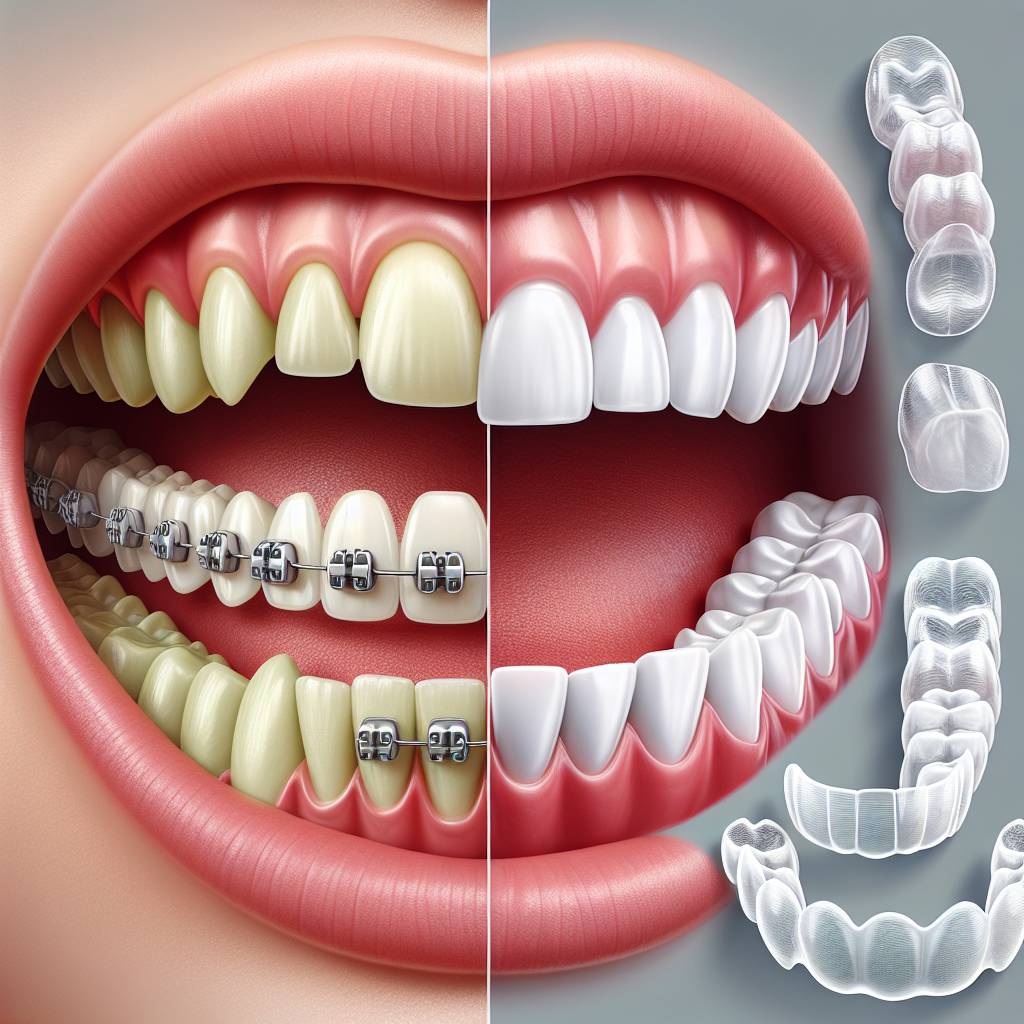Aligners are a popular and effective method for straightening teeth. They are an efficient and comfortable alternative to traditional braces, and can offer excellent results in a relatively short period of time. However, it is important to understand how long it takes for aligners to straighten teeth, as this will vary depending on the individual’s situation. This article will provide an overview of the factors that affect the amount of time required for aligners to work, as well as tips for achieving the best possible results.The average timeline for aligners to straighten teeth is typically between 6 and 18 months. This can vary depending on the severity of the misalignment and the type of treatment plan chosen. If you are considering aligners to straighten your teeth, talk to your dentist or orthodontist about their recommended timeline for achieving the desired results.
How Do Aligners Work to Straighten Teeth?
Aligners are a modern alternative to traditional braces, and they work in a similar way. They use a series of clear, plastic trays that fit snugly over the teeth. The trays are custom-made and gradually move the teeth into their correct position over time. Every two weeks, you switch out your aligners for a new set that is slightly different from the previous one. This gradual shift in alignment helps to ensure that your teeth are not damaged in the process. Each set of aligners is designed to move your teeth in small increments until you achieve the desired result. In addition, aligners are removable so you can take them out when eating or brushing your teeth, making them more comfortable and convenient than traditional braces.
Aligners can also be used to correct issues such as crowded or crooked teeth, as well as issues with bite alignment such as an underbite or overbite. The length of treatment can vary depending on the complexity of the issue and how much movement is needed to correct it. In general, most people will need between 12 and 18 months of treatment with aligners before their desired results are achieved.
Overall, aligners are an effective option for straightening teeth without having to deal with traditional braces. They are comfortable to wear and easy to remove when needed, making them ideal for adults who want a discreet way to improve their smile.
What Factors Affect Aligner Treatment Time?
Aligner treatment time can vary depending on the severity of the orthodontic problem, as well as other factors. The most important factor that affects aligner treatment time is the complexity of the orthodontic issue being treated. Generally, more complicated cases take longer to treat and require more aligners to achieve the desired result. Additionally, the number of aligners prescribed by your orthodontist will also affect your treatment time since you must wear each aligner for two weeks before moving on to the next one in the series. Other factors that can affect treatment time include patient compliance with wearing their aligners for 22 hours per day and attending regular check-ups with their orthodontist. If a patient does not adhere to their treatment plan, it may delay completion of their treatment. Additionally, some patients may need to use additional retainers or other devices to help maintain their results after they have completed their aligner treatment.
In conclusion, there are a number of factors that can affect aligner treatment time. The most important factor is the complexity of the orthodontic issue being treated, as well as patient compliance with wearing their aligners for 22 hours per day and attending regular check-ups with their orthodontist. Additionally, some patients may need additional retainers or other devices to help maintain results after they have completed their alignment treatment.
Straightening Teeth with Aligners: Benefits
Straightening teeth with aligners is one of the most popular orthodontic treatments today. Aligners are custom-made, removable trays that fit snugly over the teeth. They gently and gradually move the teeth into a desired position, providing a discreet and comfortable way to straighten crooked teeth. The benefits of using aligners to straighten teeth include:
Improved Oral Health
Straightening teeth with aligners can improve oral health by making it easier to clean and maintain healthy gums and tooth structure. When teeth are crowded or crooked, food particles can get stuck in hard-to-reach areas, increasing the risk of cavities and other dental problems. By repositioning the teeth into a better alignment, it becomes much easier to brush and floss, reducing the risk of developing dental issues.
Improved Aesthetics
Aligners can also improve a person’s appearance by giving them a straighter, more attractive smile. Crooked or misaligned teeth can make people feel self-conscious about their appearance and can even have an impact on their social life. Straightening teeth with aligners can help restore confidence and improve social interactions.
More Comfortable than Braces
Aligners are much more comfortable than traditional braces since they do not require any metal brackets or wires to be attached to the teeth. They are also removable, which makes eating and cleaning much easier than with braces. Additionally, because they are virtually invisible when worn, they provide a discreet way for adults to straighten their teeth without having to worry about an unsightly smile.
Faster Treatment Time
Another benefit of using aligners is that treatment times tend to be shorter than with traditional braces. Depending on the complexity of the case, most patients can expect to have their aligned in 12 months or less – significantly faster than what is achievable with braces.
How Long Does It Take to Put On and Remove Aligners?
Aligners are a popular choice among orthodontic patients because they are comfortable, removable, and easy to use. But how long does it take to put on and remove aligners? The answer depends on the individual patient; however, on average it takes most patients approximately 10-15 minutes to put on and remove their aligners.
It is important for patients to learn how to properly put on and remove their aligners in order to minimize discomfort and ensure that the aligners fit correctly. The process of putting on an aligner begins with thoroughly cleaning your teeth and then slowly sliding the aligner onto your teeth. It may take a few attempts before you get the hang of it, but once you do it will become quicker and easier each time.
Removing your aligners is slightly different than putting them on. To remove them, you should start by gently pushing the back of the aligner away from your teeth, then slowly working your way forward until the entire set is removed. Once again, this will become easier with practice but may take some time when first starting out.
It is important that patients take their time when putting on or removing their aligners in order to ensure that they fit properly and don’t cause any discomfort or damage to their teeth or gums. With a little bit of practice, however, most patients can easily master this simple skill in no time at all.

How Long Does Each Stage of Aligner Treatment Last?
Aligner treatment typically consists of multiple stages, each of which is designed to move your teeth into a more desirable position. The length of time each stage will last will depend on the individual situation and the severity of the alignment issues being addressed. Generally, each stage can last anywhere from two to six weeks, but some may take longer. During this time, you’ll need to wear your aligners for at least 20–22 hours per day in order to ensure proper results.
Your orthodontist will be able to provide you with an estimated timeline for your treatment based on their experience with similar cases and your individual situation. It can also vary slightly depending on how quickly your teeth respond to the aligners and if any adjustments are needed during the process.
In order to ensure that your treatment plan is progressing as expected, it’s important to make sure you keep up with all of your scheduled follow-up appointments so that any necessary adjustments can be made in a timely manner. Your orthodontist may also suggest that you switch to a new set of aligners every few weeks or months in order to continue pushing your teeth into a more desirable position.
Overall, the exact length of time for each stage of aligner treatment can vary from case-to-case depending on a variety of factors. However, with regular follow-up appointments and consistent wear times, you can rest assured that you’ll be able to see the desired results in no time!
How Long Will It Take to See Results From Wearing Aligners?
Wearing aligners is a great way to achieve straighter teeth. With the right orthodontic treatment plan, you can expect to see results in as little as two months. However, depending on the severity of your misalignment, the length of time needed for treatment may vary. In general, you should be able to see noticeable results within three to six months of wearing aligners.
Aligners are designed to gradually and gently move your teeth into position. This process is gradual and takes time. The more complex the misalignment, the longer it will take for you to see results. Your dentist or orthodontist will be able to give you a better estimate based on your individual case.
In addition, it is important to wear your aligners for at least 22 hours per day in order for them to be effective. If you do not wear them as directed, this could delay the process further. It is also important that you attend all of your scheduled appointments with your dentist or orthodontist so they can monitor your progress and make any necessary adjustments.
Overall, wearing aligners is an effective method for straightening teeth and achieving a healthier smile. With proper use and care, you should begin to see results within three months or less.
Are There Ways to Speed Up Aligner Treatment Time?
Yes, there are several ways to speed up aligner treatment time. One of the most common methods is to use a combination of accelerated aligner technology and a comprehensive patient care plan. Accelerated aligner technology uses advanced scanning and computer-aided design (CAD) software to quickly create custom-fit aligners that can be adjusted for individual patient needs. This helps reduce the time needed to move teeth into their desired positions.
In addition, comprehensive patient care plans can help reduce treatment time by providing more frequent visits and follow-up appointments with the orthodontist. These visits allow for more accurate tracking of progress and adjustments to the treatment plan if needed. Additionally, patients who are diligent in wearing their aligners for the recommended amount of time each day will see faster results than those who don’t follow through with their treatment plan.
Finally, some orthodontists offer specialized treatments such as accelerated braces or clear aligners that can reduce overall treatment time. These treatments are usually more expensive than traditional braces or clear aligners, but they may be worth it for those who want faster results. Ultimately, the best way to speed up aligner treatment time is to work closely with your orthodontist and follow their instructions carefully throughout the entire treatment process.

Conclusion
In conclusion, it takes approximately 6 to 18 months for aligners to straighten teeth. The exact timeline is determined by the severity of the misalignment and how well you follow your orthodontic treatment plan. It is important to wear your aligners for the recommended time and follow your orthodontist’s instructions in order to achieve successful results. While the process may take a while, it is worth it in the end as you will have a beautiful, healthy smile.
It is important to remember that while aligners can be used to correct mild misalignments, severe cases may require more traditional orthodontic treatments such as braces or surgery. It is important that you speak with your orthodontist about which treatment option is best for you. With proper care and time, aligners can give you the smile of your dreams in no time!

